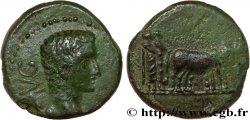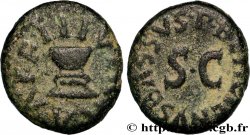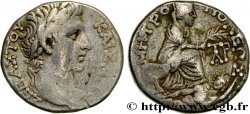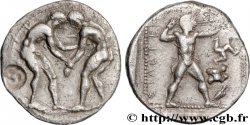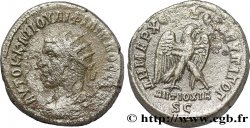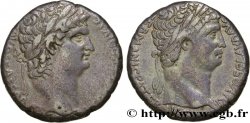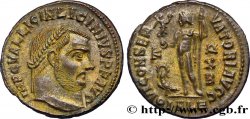bpv_141557 - AUGUSTUS Tétradrachme syro-phénicien
无库存.
所有在网站上销售的产品
价格 : 170.00 €
所有在网站上销售的产品
价格 : 170.00 €
种类 Tétradrachme syro-phénicien
日期: An 36 et 13e consulat
铸币厂名称/城市 Antioche, Syrie, Séleucie et Piérie
材质 silver
直径 26 mm
模子方针 12 h.
重量 14,06 g.
关于品相的说明
Exemplaire à l’usure importante, mais complètement lisible et identifiable, style et frappe standards pour l’emission
出版目录中的项代码 :
正面
正面的说明书 Tête laurée d’Auguste à droite entouré de la stemma (O*).
正面铭文 KAISAROS SE-BASTOU (Kaisaros Sebastou)
正面的翻译 (César Auguste).
背面
背面的说明书 Tyché (Ville d’Antioche) tourelée, voilée et drapée assise à droite sur un rocher, tenant une palme de la main droite ; à ses pieds à droite, l’Oronte nageant à droite.
背面铭文 ANTIOCEWN MHTROPOLEWS - sL - DN
背面的翻译 Antioche métropole / monogramme d’Antioche - 36 - 54.
评论
Cette émission, qui s’étend de l’an 36 (6 AD) à la mort de l’Empereur, en l’an 44 du règne (14 AD) présente aussi un type religieux plus oecuménique que ceux qu’utilisèrent les Séleucides : la Tyché de la ville d’Antioche. On peut penser que l’Antioche de l’époque, probablement une ville de 150 à 200.000 habitants, était un creuset de cultes différents et que les Romains, plutôt que d’imposer un dieu particulier, choisirent une image dans laquelle tous les Antiochéens, voire tous les habitants de la région, pouvaient se reconnaître. La statue de la Tyché représentée au revers, était la statue cultuelle de l’artiste Eutychides, si célèbre que des copies d’époque nous en sont parvenues.
En revanche, cette variante se caractérise par une légende qui fait directement référence à la ville l’Antioche, appelée ici Métropole, titre essentiel dans la hiérarchie des villes grecques, et par une datation simultanée en années régnales, ici la trente-sixième année du règne et par l’année de l’ère césarienne (qui débute à sa première visite dans la région), ici cinquante-quatrième année.
Dans la base TSP maintenue par Michel Prieur, soixante-dix exemplaires sont maintenant répertoriés, cet exemplaire est le 0057_046.
This issue, which extends from the year 36 (6 AD) to the death of the Emperor, in the year 44 of the reign (14 AD) also presents a more ecumenical religious type than those used by the Seleucids: the Tyche of the city of Antioch. It is possible to think that Antioch at that time, probably a city of 150 to 200. 000 inhabitants, was a melting pot of different cults and that the Romans, rather than imposing a particular god, chose an image in which all the Antiochians, indeed all the inhabitants of the region, could recognize themselves. The statue of Tyche depicted on the reverse was the cult statue of the artist Eutychides, so famous that examples of it from the period have come down to us..
On the other hand, this variant is characterized by a legend that directly refers to the city of Antioch, called here Metropolis, an essential title in the hierarchy of Greek cities, and by a simultaneous dating in regnal years, here the thirty-sixth year of the reign and by the year of the Caesarean era (which begins with his first visit to the region), here the fifty-fourth year.
In the TSP database maintained by Michel Prieur, seventy examples are now listed, this example is 0057_046
En revanche, cette variante se caractérise par une légende qui fait directement référence à la ville l’Antioche, appelée ici Métropole, titre essentiel dans la hiérarchie des villes grecques, et par une datation simultanée en années régnales, ici la trente-sixième année du règne et par l’année de l’ère césarienne (qui débute à sa première visite dans la région), ici cinquante-quatrième année.
Dans la base TSP maintenue par Michel Prieur, soixante-dix exemplaires sont maintenant répertoriés, cet exemplaire est le 0057_046.
This issue, which extends from the year 36 (6 AD) to the death of the Emperor, in the year 44 of the reign (14 AD) also presents a more ecumenical religious type than those used by the Seleucids: the Tyche of the city of Antioch. It is possible to think that Antioch at that time, probably a city of 150 to 200. 000 inhabitants, was a melting pot of different cults and that the Romans, rather than imposing a particular god, chose an image in which all the Antiochians, indeed all the inhabitants of the region, could recognize themselves. The statue of Tyche depicted on the reverse was the cult statue of the artist Eutychides, so famous that examples of it from the period have come down to us..
On the other hand, this variant is characterized by a legend that directly refers to the city of Antioch, called here Metropolis, an essential title in the hierarchy of Greek cities, and by a simultaneous dating in regnal years, here the thirty-sixth year of the reign and by the year of the Caesarean era (which begins with his first visit to the region), here the fifty-fourth year.
In the TSP database maintained by Michel Prieur, seventy examples are now listed, this example is 0057_046







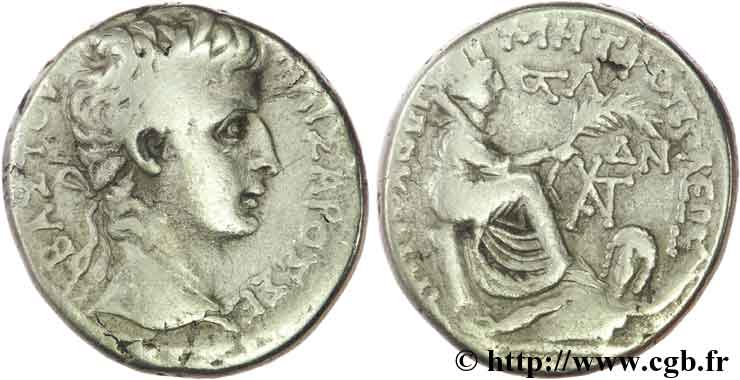
 对产品描述纠错
对产品描述纠错 打印
打印 分享我的选择
分享我的选择 提问
提问 Consign / sell
Consign / sell
 产品介绍
产品介绍
